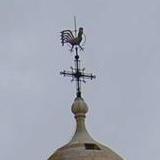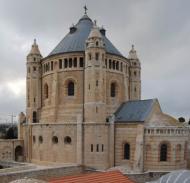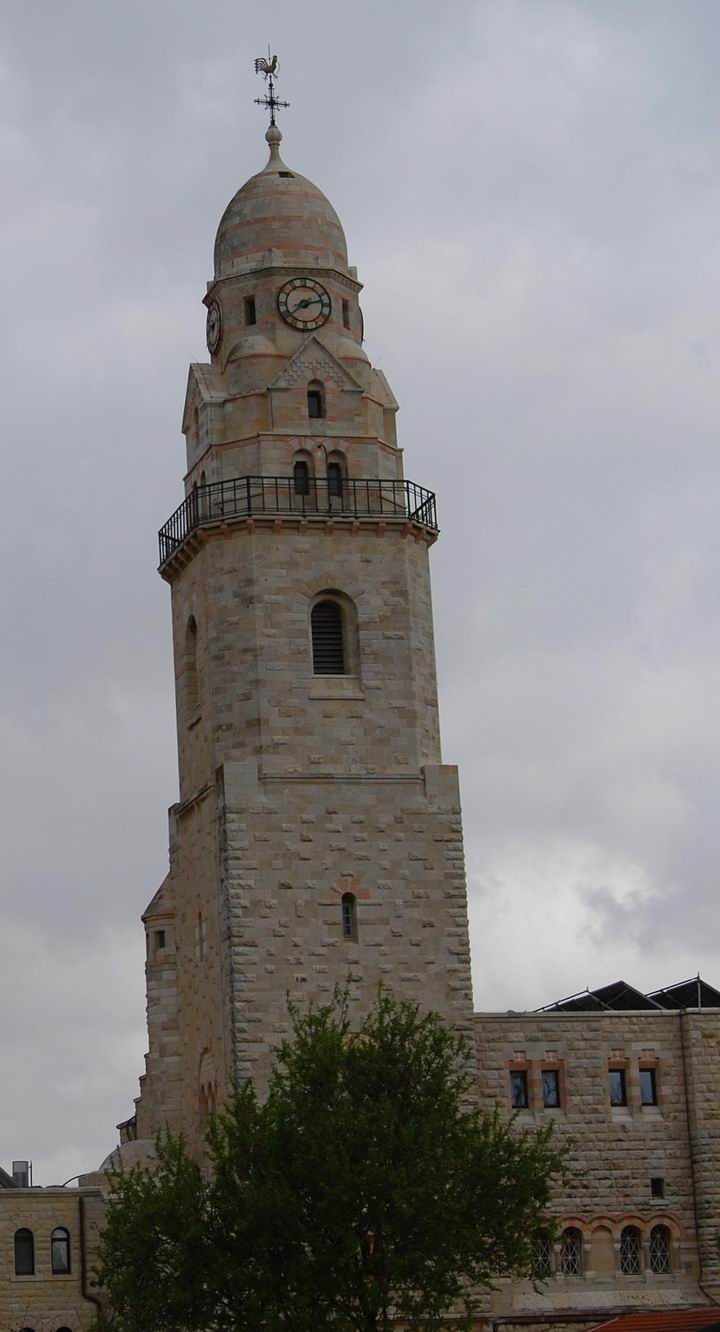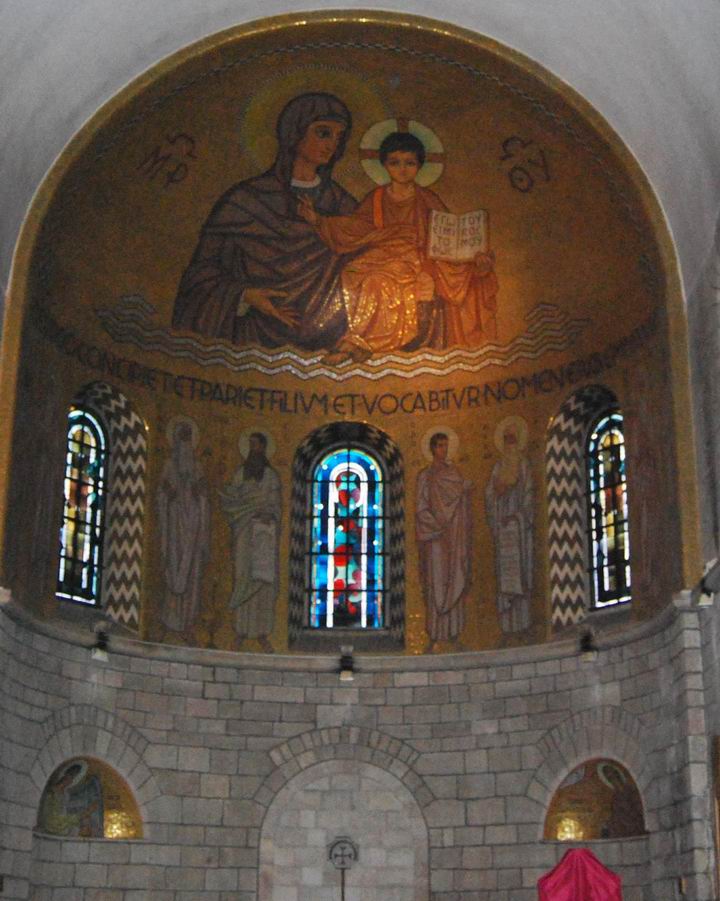A grand German Benedictine Abbey located on top of Mount Zion, commemorating the memory of Virgin Mary, in the traditional site of her death.
Home > Sites > Jerusalem > Mount Zion > Dormition Abbey
Contents:
Overview
Location
History
Photos
* Exterior
* Interior
* Chapels
* Mary sleeping
* In the Crypt
Links
Overview:
The abbey was founded by German Benedictine monks in 1898 and is dedicated to the Virgin Mary, who is believed to have died and been assumed into heaven (dormition) at the end of her life. The name Dormition means “Eternal sleep”.
The abbey’s church is one of the most striking buildings in Jerusalem, with a large dome that dominates the skyline. The interior of the church is decorated with beautiful mosaics and frescoes, including an image of Mary’s dormition.
The abbey includes a guesthouse for pilgrims, a library, and a museum. It is also home to a community of monks who follow the Rule of Saint Benedict, which emphasizes prayer, study, and work.
The complex was built in the beginning of the 20th century over the ruins of a Byzantine church. It is also called Hagia-Maria-Sion Abbey, named after the Byzantine church.
Location:
The site is located on Mount Zion, outside of the old city walls and 100M south-west to Zion gate. It is easily accessed from the parking lot near the Zion gate.

History :
- Hellenistic, Roman and Byzantine periods
During the Hellenistic and Roman periods, this area was within the walled “upper” city. It was also the site where some of the events of the last days of Jesus have happened.
Several hundred years later, during the Byzantine period, the early Christians built several churches around this Holy site, such as the church called Hagia-Sion. The site was a traditional place where the pilgrims commemorated the death of the blessed virgin Mary, and many wished to be buried around the sacred place. Other important sites are adjacent to this location and increased the Holiness of this sacred site – the location of the last supper (“Coenaculum”) and the tomb of King David.
- Middle ages
After the Arab conquest, the area remained in ruins from the 7th century until the 12th century. Then, the Crusaders rebuilt some of the structures on Mount Zion (12-13th century). They were destroyed later after the fall of the Crusaders Kingdom, and remained in ruins until the 19th century. The Ottomans did not include the area inside the 16th century wall.
- Late Ottoman period
The Ottomans gave the land as a gift to the Germans, letting them build a new structure. The ceremony of the establishment of the Dormition Abbey was held in 1898 during the historic visit of the German Kaiser Wilhelm II in Jerusalem and the Holy Land. His visit to the Holy Land and Jerusalem was a great event in the Holy Land, and caused great excitement across the country.
The cornerstone laying ceremony was held in March 1906. The grand Abbey was designed by Heinrich Renard, and constructed in the years 1901-1910. It included a large church, a bell tower and a number of buildings. It was named “Dormitio Beatae Mariae Virginis” or “Holy sleep of Virgin Mary”, and in short the “Dormition”. It honored the memory of Mary who, according to tradition, has lived after His resurrection, and died.
- Modern times
In 1948, during the Independence war, the Dormition was damaged by shelling during the bloody battles on Mount Zion. For 20 years it was used by the IDF as a lookout tower on the border with Jordan, and was reunited with East Jerusalem and restored after the 6-day-war.
The church today is open to the public and is a popular place for pilgrims and tourists.
Photos:
(a) Exterior:
The photo below shows the Dormition Basilica and the bell tower from the balcony of the tomb of David.
Click on the photos to view in higher resolution…
A closer view of the basilica is seen below.
The beauty and grand design of the church is even more impressive from the alley that leads from the Zion gate. The sign (“Hagia Sion”) points left to the “Coenaculum” and right to the abbey.
The Bell tower is crowned with a sign of the cock, similar to the Gallicantu church. The Biblical text (Mark 14: 26-72) describes the story of Peters’ triple denial of Christ and the cock crowing twice, which happened on Mount Zion.

The story is as follows: Jesus was sitting with his disciples before his arrest, and doubted their loyalty. Peter declared that he will not be among them, but Jesus predicted that within that night, even before the 2nd crow of the cock, Peter will deny him 3 times. This is exactly what has happened, as Peter found out himself.
(b) Church:
The entrance to the church is seen in the photo below, but the visitors normally enter the hall from a side entrance.
The photo below shows a section of the interior inside the basilica, with a mosaic picture of Mary and child Jesus in the center of the semicircular apse above the altar.
Jesus holds an open book with the inscription from John 8, 12 (“I am the light of the world”), words that Jesus said when he visited Mount of Olives. Underneath are pictures of eight Prophets, and a Latin verse from Isaiah 7, 14 with the prophecy of the coming of the Messiah: “…Behold, a virgin shall conceive, and bear a son, and shall call his name Immanuel”. The Greek initials on both sides of Mary and Jesus mean “Mary, mother of God”.
The two lower niches depict the Annunciation, with inscriptions on the right niche: “I am the Lord’s servant”; and on the left: “Hail, full of grace”.
The floor is decorated with the symbols of the Zodiac, names of Prophets, and a verse from Proverbs (8, 23-25) written on its circumference.
(c) Mosaics:
Around the walls are 6 side chapels which are decorated by mosaics, and are one of the highlights of the site. These are seen below, from right to left. The chapel below, the first on the right side of the hall, is of St. Benedict – the founder of the order of the German Benedictines who were entrusted with the Dormition.
The second chapel to the right: Mary, holding infant Jesus, greet pilgrims (such as St. Willibaldus – the first English pilgrim to Jerusalem) and the three wise kings.
On the right side, closest to the center, is a chapel with the family tree of Jesus.
The chapel that is the first on the left of the center depicts Mary holding child Jesus, surrounded by Bavarian bishops.
In the center left chapel – John the Baptist standing on the banks of the Jordan river.
On the left side is a chapel with St. Boniface (center), St. Lioba and St. Mauritius.
(d) “Sleeping” Mary:
From the church are two spiral staircases that lead down to the crypt. The crypt is a round pillared room (“Rotunda”), which is located in a level under the church. In the center of the crypt, surrounded by six pillars, is a sculpture of Mary’s deathbed, made of ivory and cherry wood. Visitors light up candles before the sculpture.
On the ceiling of the cape above Mary are Jesus (in the center) surrounded by famous Biblical women figures: Eve, Esther, Ruth, Yael, Judith and Mary sister of Moses; they are here to honor Mary.
(e) In the Crypt:
Around the walls of the round crypt are several chapels, donated and designed by different countries. A gallery of these altars is seen below.
In the photo below is the most impressive chapel, located at the end of a long pillared hall.
Another altar is seen below:
The next chapel, seen below, was donated by the Ivory Coast, and consist of Ivory and black Ebony wood. There are two Greek letters inscribed on the altar – Alpha and Omega – the first and last letters of the Greek alphabet. As per Revelation 1: 8: “I am Alpha and Omega, the beginning and the ending “.
A chapel donated by Hungary is seen below.
And here’s another altar.
A mosaic picture on one of the walls:
And a painting on the ceiling of another corner, showing Mary at her deathbed.
Links:
- Greek initials – info page in BibleWalks.com
- Beit Jamal – St. Stephen’s and Rabbi Gamaliel remains were transferred in 415 AD from Beit Jamal
BibleWalks.com – walk with us through the sites of the Holy Land
St. Francis <—previous Jerusalem site–<<< All Sites >>>—> King David’s tomb
![]()
This page was last updated on Mar 19, 2023 (new overview)
Sponsored links:



